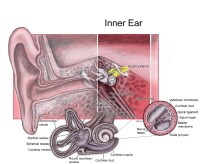In 1979, McCabe first described a cohort of sufferers with idiopathic, swiftly revolutionary bilateral sensorineural listening to loss (SNHL). These sufferers' hearing more desirable after remedy with corticosteroids, thereby suggesting an autoimmune pathogenesis. The hallmark of this clinically diagnosed situation is the presence of a impulsively innovative, continuously fluctuating, bilateral SNHL over a duration of weeks to months. The development of listening to loss is simply too rapid to be diagnostic for presbycusis and too gradual to conclude a diagnosis of sudden SNHL. Vestibular symptoms, corresponding to true vertigo, generalized imbalance, and ataxia, may be existing.
See the picture below.
 internal ear. NextPathophysiology
internal ear. NextPathophysiologyThe term autoimmune inner ear disease (AIED) implies a direct assault of the immune machine upon an endogenous inside ear antigen. most of the proof linking the immune gadget to cochleovestibular dysfunction is indirect; subsequently, immune-mediated interior ear disease may be a most well-liked time period. AIED is a medical analysis according to its assorted clinical course, immune check results, and therapy response. an important diagnostic finding is growth in hearing seen with a trial of immunosuppressants.
particular standards for idiopathic innovative bilateral sensorineural hearing loss (IPBSNHL) include bilateral SNHL of at least 30 dB at any frequency with progression in at the least one ear, outlined as a threshold shift that is greater than 15 dB at any frequency or 10 dB at 2 or more consecutive frequencies or a big trade in discrimination ranking. This definition excludes patients with sudden SNHL occurring in less than 24 hours, which extra doubtless is as a result of a microvascular or viral etiology.
a definite subset of sufferers with presumed Ménière illness (idiopathic endolymphatic hydrops) in fact may have Ménière syndrome, wherein the underlying pathophysiology is immune mediated. normally, Ménière illness is at first identified in these sufferers; however, fluctuating hearing loss within the contralateral ear develops later. this transformation may recommended a workup for AIED. Hughes et al discovered that approximately one 1/2 of their sufferers with AIED have manifestations of autoimmune Ménière syndrome.[1, 2]
PreviousNextEpidemiologyFrequencyUnited States
for the reason that existence of autoimmune internal ear disease (AIED) has been known handiest considering the fact that 1979, incidence is tough to determine. contemporary studies within the literature from huge referral centers are in accordance with rather small pattern sizes of sufferers who match the standards for prognosis of AIED. As diagnostic tests for the condition turn into extra explicit and more is known about AIED, extra sufferers will probably be recognized who've an autoimmune foundation for inner ear symptoms.
sex
The condition has been prompt to be extra in style in feminine patients who could or would possibly not have concomitant systemic autoimmune illness than in male patients.
Age
In most patients, preliminary onset of signs occurs at age 20-50 years. cases in pediatric patients are special.[3]
PreviousProceed to scientific Presentation , Autoimmune illness of the inside Ear

No comments:
Post a Comment
Note: Only a member of this blog may post a comment.